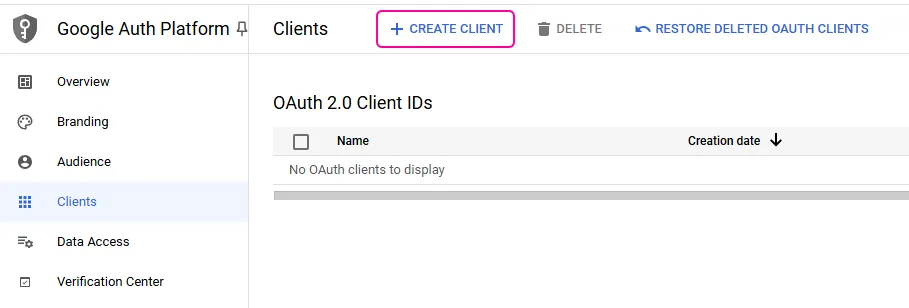Firebase Cloud Messaging
To use Firebase Cloud Messaging, you must have a Google account.
To create the connection:
Optional: In the Connection name field, enter a name for the connection.
Optional: Switch on Show advanced settings and enter your Google Cloud Platform project client credentials. For more information, see the Creat and configure a Google Cloud Platform project section below.
Click Sign in with Google.
If prompted, authenticate your account and confirm access.
You've successfully created the connection and can now use the Firebase Cloud Messaging app in your . If you want to make changes to your connection in the future, follow the steps here.
To create a Google Cloud Platform project:
Log in to the Google Cloud Platform using your Google credentials.
On the welcome page, click Create or select a project > New project. If you already have a project, proceed to the step 5.

Enter a Project name and select the Location for your project.
Click Create.

In the top menu, check if your new project is selected in the Select a project dropdown. If not, select the project you just created.
To create a new project or work in the existing one, you need to have the serviceusage.services.enable permission. If you don’t have this permission, ask the Google Cloud Platform Project Owner or Project IAM Admin to grant it to you.
To enable the required APIs:
Open the left navigation menu and go to APIs & Services > Library.
Search for the following API: Firebase Management API and Firebase Cloud Messaging API.
Click the relevant API, then click Enable. If you see the Manage button instead of the Enable button, you can proceed to the next step: the API is already enabled.
To configure your OAuth consent screen:
In the left sidebar, click Google Auth Platform.
If you don't see Google Auth Platform in the left sidebar, click View all products at the top of it, then pin Google Auth Platform to the sidebar.

Click Get Started.
In the Overview section, under App information, enter Make as the app name and provide your Gmail address. Click Next.
Under Audience, select External. Click Next.
For more information regarding user types, refer to Google's Exceptions to verification requirements documentation.
Under Contact Information, enter your Gmail address and click Next.
Under Finish, agree to the Google User Data Policy.
Click Continue > Create.
Click Create OAuth Client.

In the Branding section, under Authorized domains, add make.com and integromat.com. Click Save.
Optional: In the Audience section, add your Gmail address on the Test users page, then click Save and continue if you want the project to remain in the Testing publishing status. Read the note below to learn more about the publishing status.
In the Data Access section, click Add or remove scopes, add the following scopes:
https://www.googleapis.com/auth/userinfo.profile
https://www.googleapis.com/auth/userinfo.email
https://www.googleapis.com/auth/firebase.messaging
https://www.googleapis.com/auth/firebase
You can add scopes using:
- A table with filters
- A window to manually enter scopes:
Click Update.
Click Save.
Publishing Status
Testing: If you keep your project in the Testing status, you will be required to reauthorize your connection in Make every week. To avoid weekly reauthorization, update the project status to In production.
In production: If you update your project to the In production status, you will not be required to reauthorize the connection weekly. To update your project's status, go to the Google Auth Platform, the Audience section, and click Publish app. If you see the notice Needs verification, you can choose whether to go through the Google verification process for the app or to connect to your unverified app. Currently connecting to unverified apps works in Make, but we cannot guarantee the Google will allow connections to unverified apps for an indefinite period.
For more information regarding the publishing status, refer to the Publishing status section of Google's Setting up your OAuth consent screen help.
To create your client credentials:
In Google Auth Platform, click Clients.
Click + Create Client.

In the Application type dropdown, select Web application.
Update the Name of your OAuth client. This will help you identify it in the platform.
In the Authorized redirect URIs section, click + Add URI and enter the following redirect URI:
https://www.integromat.com/oauth/cb/fcm

Click Create.
Click the OAuth 2.0 Client you created, copy your Client ID and Client secret values, and store them in a safe place.
You will use these values in the Client ID and Client Secret fields
You can look for Firebase Cloud Messaging templates in Make's template gallery, where you'll find thousands of pre-created .